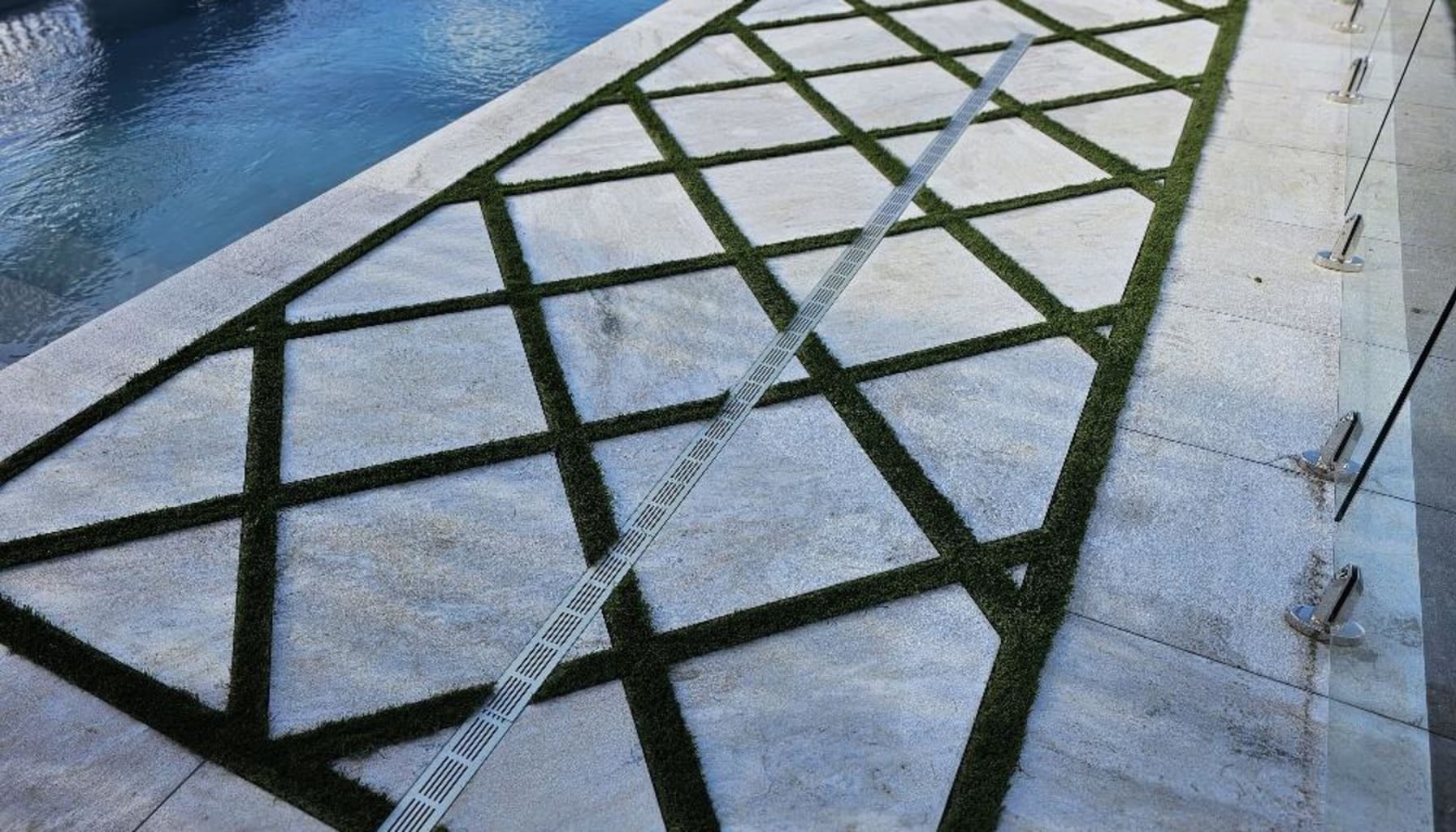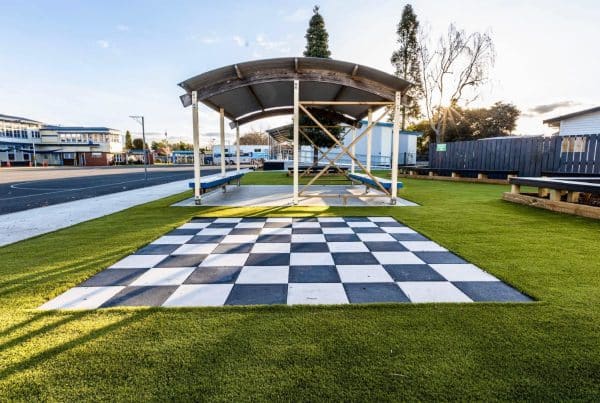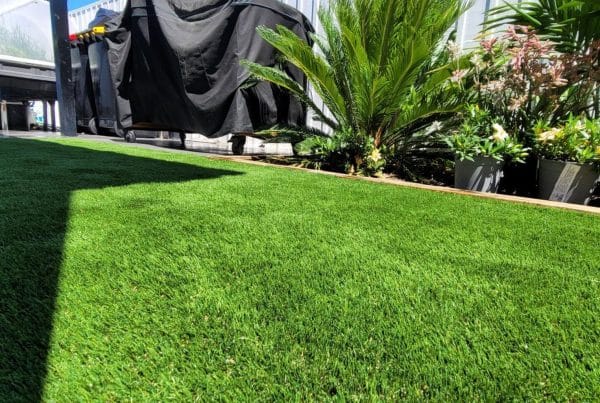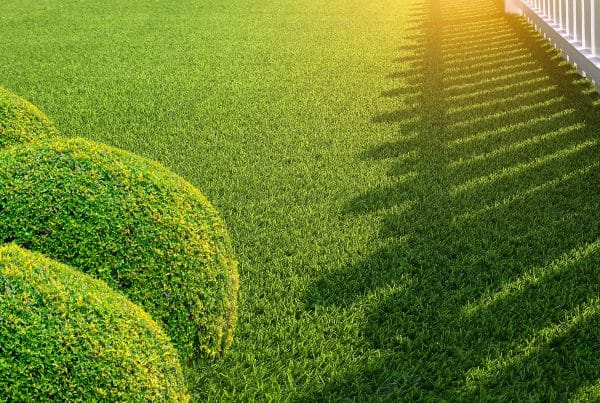Synthetic turf grass has revolutionized landscaping, offering a low-maintenance alternative to natural lawns. At Unreal Lawns & Courts, we’ve seen firsthand how this innovative solution transforms outdoor spaces.
From residential yards to sports fields, synthetic turf provides year-round greenery without the hassle of mowing, watering, or fertilising. This comprehensive guide will explore the types, benefits, and selection criteria for synthetic turf grass, helping you make an informed decision for your property.
Types of Synthetic Turf Grass
Synthetic turf grass offers various options, each designed for specific needs and preferences. Understanding these types will help you make an informed decision for your project.
Polyethylene Grass: The Popular Choice
Polyethylene grass stands out as the most common type of synthetic turf. It boasts a soft texture and natural appearance, making it ideal for residential lawns and sports fields. This grass type resists UV rays and maintains its color and shape over time. A 2023 industry report by Synthetic Turf Council reveals that polyethylene grass accounts for 70% of all synthetic turf installations in residential settings.
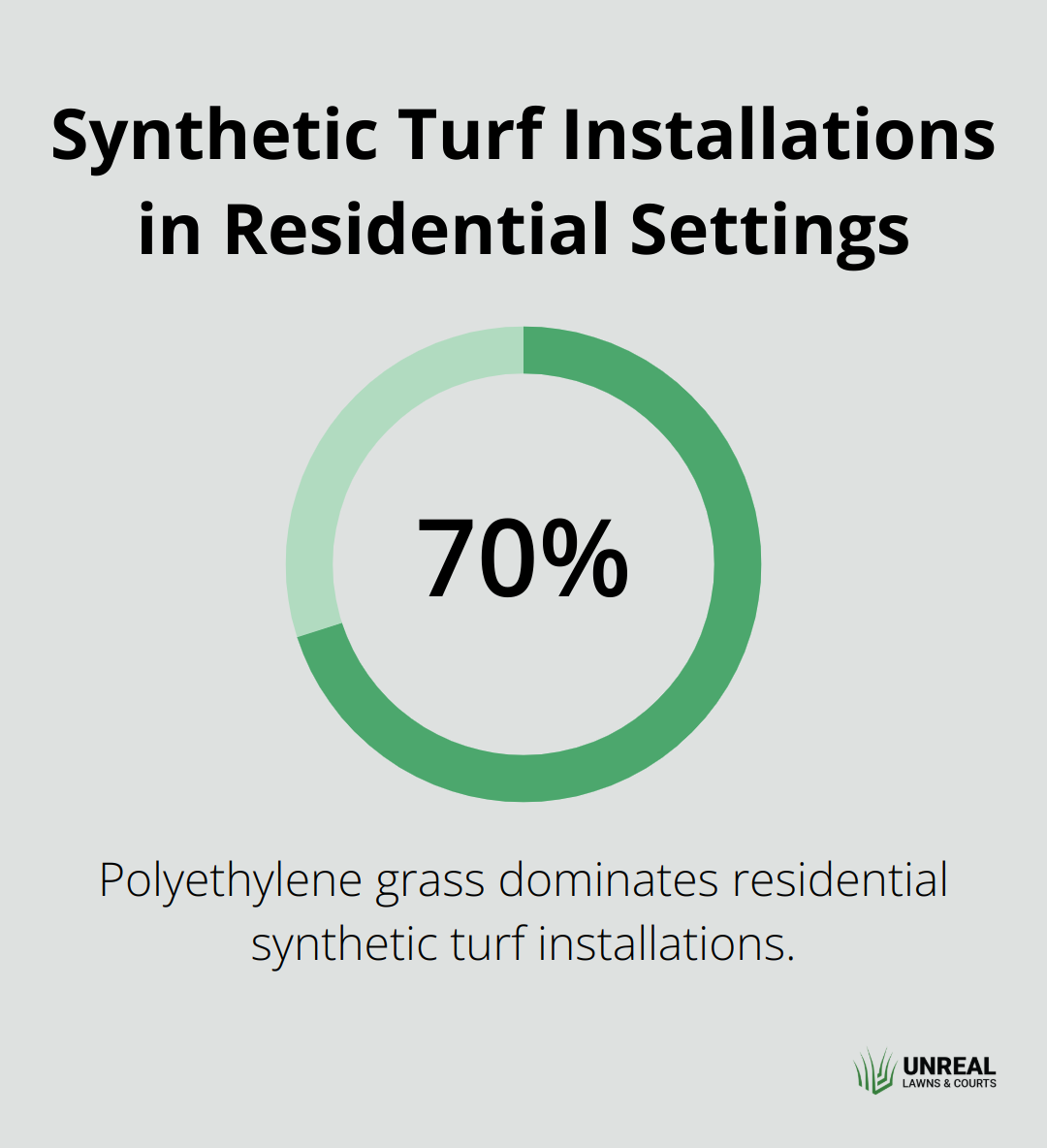
Polypropylene Grass: Budget-Friendly Option
Polypropylene grass attracts customers with its affordability. While less durable than polyethylene, it suits areas with light to moderate foot traffic. This grass type often finds use in indoor applications or areas with limited sun exposure. However, polypropylene grass may not resist heat as well as other options, so consider your local climate when selecting this type.
Nylon Grass: Tough and Resilient
For high-traffic areas or spaces that demand extra durability, nylon grass takes the lead. As the strongest synthetic grass fibre available, it withstands heavy use and extreme temperatures. Sports fields and commercial spaces often choose nylon grass for its resilience. However, it typically costs more than other options and may feel less soft underfoot.
Hybrid Combinations: Best of Both Worlds
Hybrid synthetic turf combines different fibre types to maximse benefits. For example, a blend of polyethylene and nylon offers the softness of polyethylene with the durability of nylon. These combinations gain popularity in sports applications where both performance and player comfort matter. However, a study found that play on synthetic turf resulted in a 16% increase in lower extremity injuries per play compared to natural turf.
When selecting synthetic turf, consider factors such as intended use, local climate, and budget. Your choice of artificial grass should align with your specific needs and perform well in your local environment while meeting your aesthetic and functional requirements.
Now that we’ve explored the main types of synthetic turf grass, let’s examine the benefits of installing this innovative landscaping solution.
Benefits of Installing Synthetic Turf Grass
Synthetic turf has revolutionized landscaping, offering numerous advantages over traditional natural grass. This innovative solution transforms outdoor spaces, providing long-lasting benefits that natural grass cannot match.
Minimal Maintenance Requirements
Synthetic turf significantly reduces maintenance time and costs. A comparison between artificial turf and natural grass examines six major considerations, including safety issues and cost analysis. This can translate to substantial savings for property owners.
With synthetic turf, you eliminate the need for mowing, watering, and fertilising. A quick brush every few weeks usually suffices to keep your lawn looking pristine. This low-maintenance aspect appeals particularly to busy homeowners, businesses, and municipalities aiming to reduce groundskeeping expenses.
Substantial Water Conservation
Water conservation is a critical issue, especially in drought-prone areas. Synthetic turf offers a solution by eliminating the need for regular watering. Switching to synthetic turf can save thousands of litters of water each year.
For example, a 100 square metres of lawn would save a significant amount of water annually. This not only reduces water bills but also contributes to broader water conservation efforts in your community.
Year-Round Aesthetic Appeal
Synthetic turf maintains its lush, green appearance throughout the year, regardless of weather conditions. Unlike natural grass that can turn brown during dry spells or become muddy after rain, synthetic turf remains pristine. This consistent aesthetic enhances property value and curb appeal.
A survey by the National Association of Realtors found that well-maintained landscaping can increase a property’s value by up to 12%. With synthetic turf, you invest in a long-term solution that keeps your outdoor space looking its best, season after season.
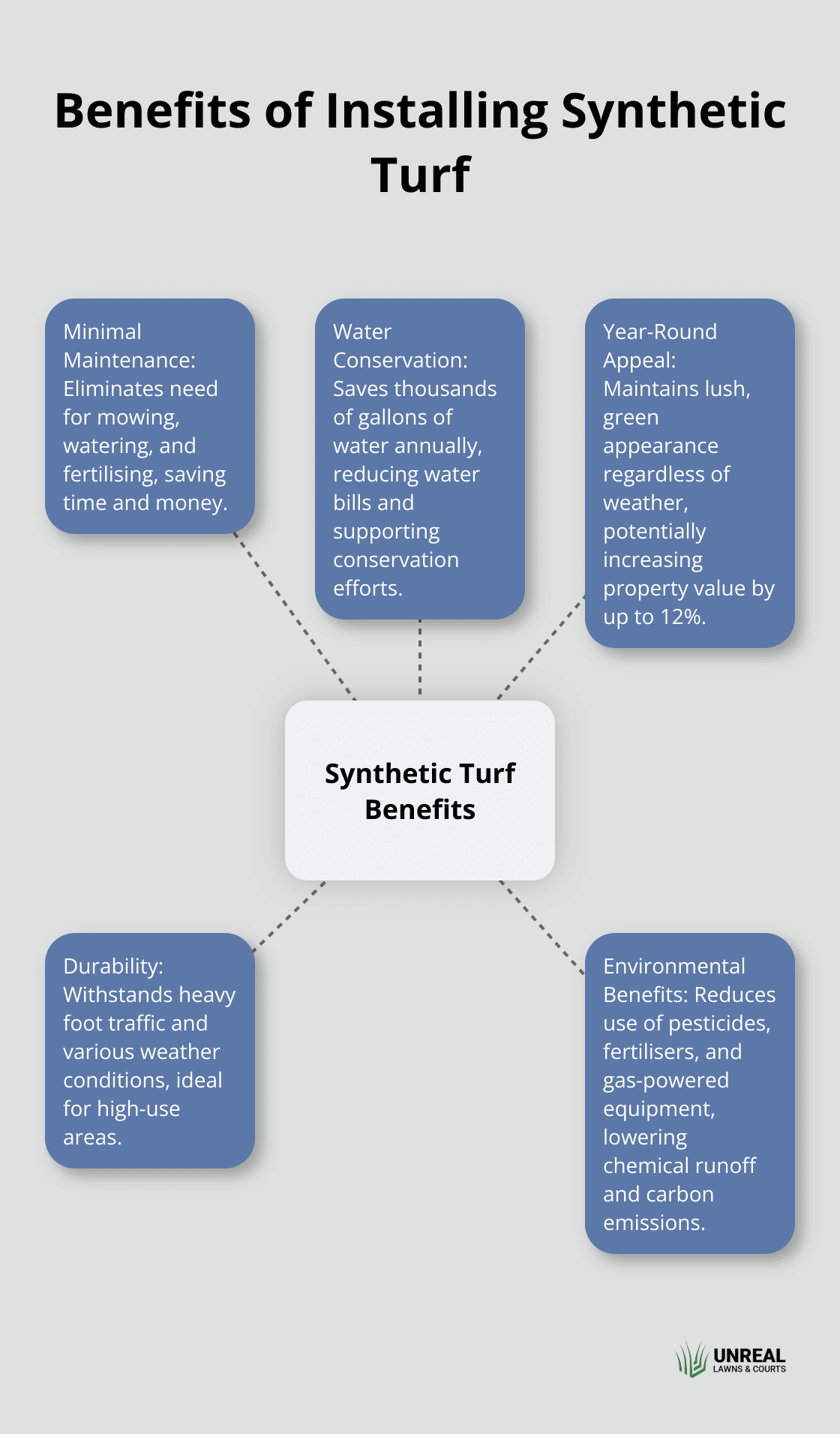
Durability and Cost-Effectiveness
Synthetic turf proves highly durable, withstanding heavy foot traffic and various weather conditions. Its resilience makes it ideal for high-use areas such as sports fields, playgrounds, and commercial spaces. While the initial installation cost may be higher than natural grass, the long-term savings on maintenance, water, and replacement costs often outweigh this initial investment.
Environmental Benefits
Beyond water conservation, synthetic turf offers additional environmental advantages. It eliminates the need for harmful pesticides and fertilisers, reducing chemical runoff into local water systems. Moreover, synthetic turf doesn’t require gas-powered lawn equipment, reducing carbon emissions associated with lawn maintenance.
As we move forward, let’s explore how to choose the right synthetic turf for your specific needs, considering factors such as intended use, climate, and quality.
How to Select the Perfect Synthetic Turf Grass
Match Turf to Purpose
The intended use of your synthetic turf influences your choice significantly. High-traffic areas like sports fields or commercial spaces require denser, more resilient options such as nylon or hybrid blends. These withstand intense use without losing shape or durability. For residential lawns or decorative areas, softer polyethylene grass offers a more natural look and feel.
A 2022 study by the Sports Turf Managers Association revealed that 85% of professional sports venues using synthetic turf chose hybrid or nylon options due to their superior durability and performance under intense use. This statistic underscores the importance of aligning turf type with usage intensity.
Consider Climate Factors
Your local climate plays a key role in turf selection. Areas with high UV exposure need turf with strong UV resistance to prevent fading and degradation. Regions with heavy rainfall require turf with excellent drainage capabilities to prevent water pooling.
To ensure efficient drainage, you need a 2 per cent minimum slope. Before installing turf on organic ground, you need to check its composition. For clay surfaces, additional drainage measures may be necessary.
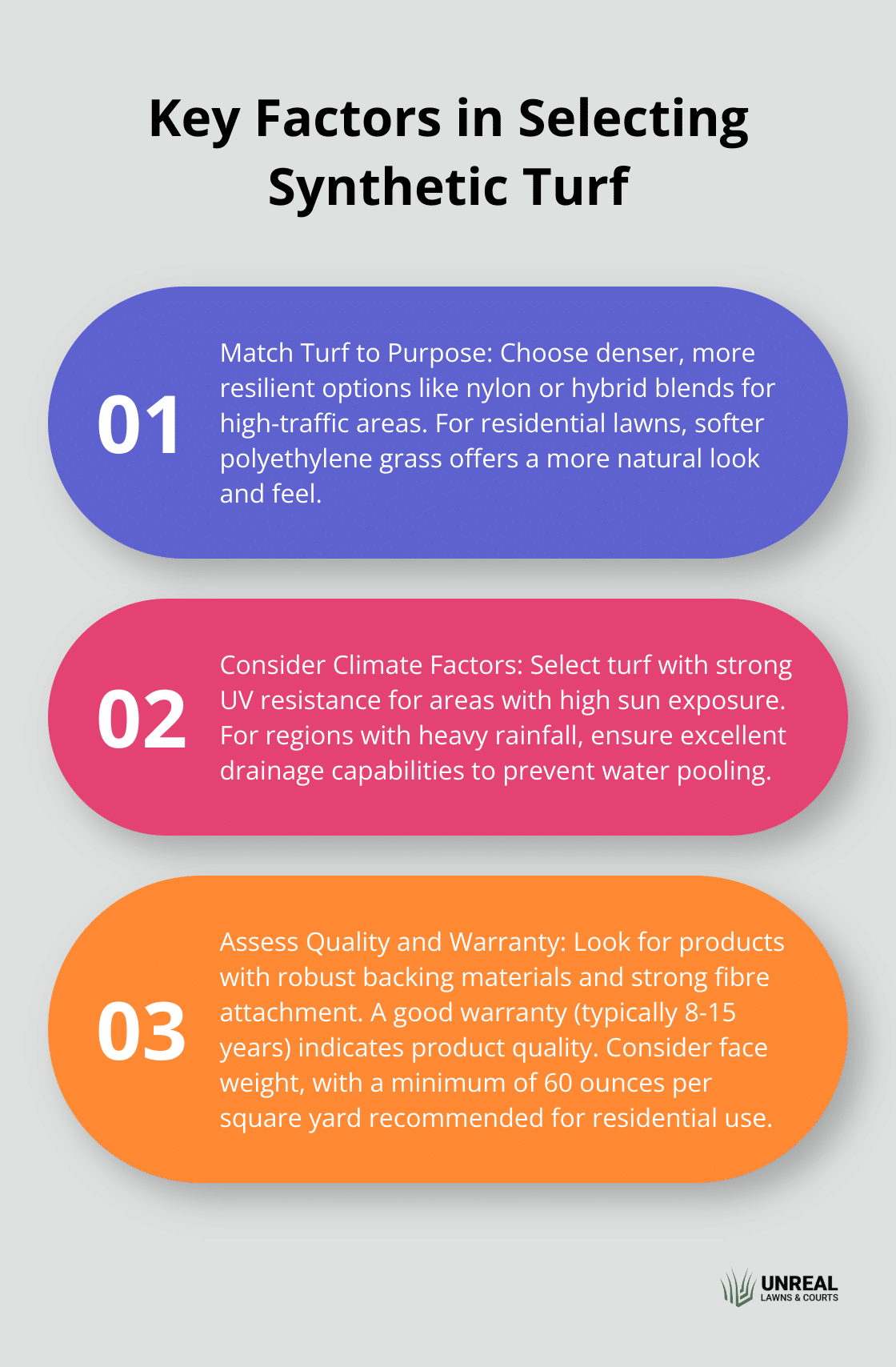
Assess Quality and Warranty
High-quality synthetic turf pays off in the long run. Look for products with robust backing materials and strong fibre attachment. A good warranty indicates product quality. Most reputable manufacturers offer warranties ranging from 8 to 15 years, covering issues like excessive fading or fibre loss.
When assessing quality, pay attention to the turf’s face weight (which measures the amount of fibre per square yard). A higher face weight generally indicates a denser, more durable turf. For residential applications, experts recommend a minimum face weight of 60 ounces per square yard.
Evaluate Cost and Installation Factors
Upfront costs for synthetic turf can be higher than natural grass, but consider the long-term savings on maintenance and water usage. Water saving is significant with synthetic turf. Based on a 50m2 area, approximately 60,000 litres of water can be saved annually.
Installation costs vary based on factors like site preparation and turf quality. On average, professional installation ranges from $70 to $100 per square metre. While DIY installation might seem cost-effective, professional installation ensures proper drainage, seam joining, and infill application (all crucial for the turf’s longevity and performance).
When comparing quotes, ask about the complete installation process, including base preparation and infill materials. Some companies might offer lower prices but cut corners on essential steps, leading to problems down the line.
Final Thoughts
Synthetic turf grass has revolutionized landscaping, offering unmatched benefits over traditional lawns. It provides low maintenance, water conservation, year-round appeal, and durability, making it a practical and attractive solution for various outdoor spaces. The advantages of synthetic turf extend to environmental sustainability and long-term cost-effectiveness, making it a smart investment for property owners.
Choosing the right synthetic turf grass involves careful consideration of factors such as intended use, local climate, quality, and installation requirements. Ongoing advancements in materials and manufacturing processes continue to enhance the realism, durability, and environmental friendliness of synthetic turf products. As urban development increases and water conservation becomes more critical, synthetic turf grass will play a significant role in modern landscaping solutions.
Unreal Lawns & Courts offers premium artificial grass solutions tailored to New Zealand’s unique climate and lifestyle needs. Their expertise in synthetic turf installation (which includes proper drainage and infill application) ensures high-quality, long-lasting outdoor surfaces that combine functionality with aesthetic appeal. Property owners who embrace this innovative solution can enjoy beautiful, low-maintenance outdoor spaces while contributing to water conservation efforts.

